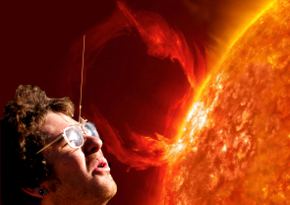Supernova countdown tightened
 Betelgeuse,one of the best known stars in the galaxy, could become the first observed supernova in over four centuries.
Betelgeuse,one of the best known stars in the galaxy, could become the first observed supernova in over four centuries.
Located 700 light years from Earth, Betelgeuse has fascinated scientists for years due to its colossal size and relatively close proximity.
Stars such as Betelgeuse end their billion-year lifespans in a dramatic fashion, culminating in a supernova - an explosive event that can briefly outshine an entire galaxy.
During that final state, the star can emit a billion times more light, and “would be visible both during the day and the night,” says Dr Nick Lomb, from the University of Southern Queensland.
“There hasn’t been a supernova in our galaxy since German astronomer Johannes Kepler saw one in 1604,” says Dr Lomb.
“So, Betelgeuse becoming a supernova would be an exciting event.”
Excitement is growing following recent studies, including one published in the Monthly Notices of the Royal Astronomical Society, which have refined predictions for Betelgeuse's demise to possibly within the next 300 years.
The death of the famed red supergiant star in the constellation of Orion would be the first such observation since Johannes Kepler's documentation of a supernova in 1604.
The phenomenon would not only illuminate the night sky but also scatter elements across the universe, seeding the formation of new stars and planets.
The explosion of Betelgeuse is anticipated to be a safe yet awe-inspiring event for Earth's inhabitants, as its distance ensures no harmful effects on the planet.
Adding to the intrigue, recent observations have puzzled scientists with Betelgeuse's unexpectedly rapid spin.
A team from the Max Planck Institute for Astrophysics suggests this could be an illusion caused by the star's tumultuous surface.
Massive stars are expected to have relatively sedate rotation speeds, because as they expand during their red giant phase, the conservation of angular momentum suggests their rotation should slow.
Yet, recent observations made with the Atacama Large Millimeter/submillimeter Array (ALMA) located in Northern Chile, show that Betelgeuse is rotating at around 18,000 kilometres per hour. The research is published in the Astrophysical Journal Letters.
However, that interpretation assumes Betelgeuse is a perfectly round sphere. Researchers know that the surface of the red supergiant star is in fact turbulent with boiling bubbles. Some of those bubbles are as large as Earth's entire orbit around the sun.
Researchers are now undertaking further observations of Betelgeuse to assess its rotational speed and better understand how its boiling surface affects such measurements, to further pin down its potential end date.








 Print
Print